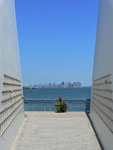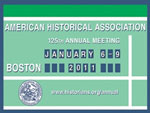The degree of difficulty educators face when dealing with new technologies varies, but the sensation of feeling like a “newbie” when it comes to technology can often create tech-wariness among teachers. Educators should not feel this way.
Teachinghistory.org's presentation at the 2011 American Historical Association (AHA) conference, entitled “Teaching and Learning History in the Digital Age,” offered attendees exposure to free and easy-to-use tools that can work for teachers, regardless of their technological abilities. The main message of this presentation? Start small and be willing to face unexpected hiccups along the way.
Starting Out with Digital Tools
One educator, nearing retirement, was curious about digital tools as I shared with her the topic of my presentation while walking to another conference event. She was initially interested in attending my presentation but found that the whole topic of digital tools was too complex for her.
Start with what feels comfortable.
Besides, where would she even begin searching for new media tools? She found herself regretting her earlier decision to skip panels on digital tools. It seemed that her own dilemma—where to start looking for digital tools—is not unique. The goal of the presentation was to help educators like her gain exposure to technology that is easily available. My advice to her was the same as I provided the audience: Start with what feels comfortable.
Some educators might enjoy exploring complex tools, “going under the hood,” and learning new skills. Other educators might want a ready-made tool, like Wordpress, to help build a course website. The open-source nature of platforms and browsers like Wordpress, Firefox, Zotero, and Omeka allow daring educators to invent the new plug-ins that can radically transform educational tools. For the less adventurous educators, these platforms allow them to take advantage of the work of others.
So . . . What Can Educators Do on the Web?
The presentation at AHA was, in part, inspired by a recent series of articles by Robert Townsend in AHA's Perspectives on History (Oct., Nov., Dec.). In his findings, which surveyed over 4,000 two- and four-year college faculty, Townsend noted that educators are increasingly embracing digital tools. Nearly 70% of respondents characterized themselves as “active users”—a number that might surprise many. Upon closer inspection, however, active digital users are mostly younger (no surprise here), and the most popular tools are not what many digitally-savvy educators would necessarily consider cutting-edge: digital cameras, scanners, search engines, word processors, and online archive searches. Tools that have the potential to change how we “do” history—text mining, social media, GIS/mapping, and data visualizations—received few responses in AHA's survey.
My immediate reaction to Townsend's articles? Is that it? On the one hand, I found it rather underwhelming to see what passes as “digital history” in the second decade of the 21st century. On the other hand, a utopian view of this subject is probably not well-served considering the budgetary and curricular constraints teachers face; lasting change rarely develops out of radical, or revolutionary, change. A more measured approach would be to acknowledge that significant uses of technology in the history classroom will gradually occur through funding for technology training, or, more likely, through collaborative exchanging of ideas among staff.
Key Areas in Digital Tool Use
The presentation at AHA, then, was structured to address three or four key areas teachers address in their planning stages. As always, these tools are helpful, but only when applied with thoughtful consideration towards teaching and research (several good reads recently posted on Edwired deal with the perils and possibilities of web tools).
Digital Tools for Presentations
- Google Maps is a good instrument for examining memorials, battlefields, and other historical sites, while also allowing users to create new and interesting links between locations.
- Google Earth allows users to create placemarks, polygon shapes, paths, and images on Google's database of satellite images. This is ideal for creating original maps or recreating routes on military campaigns, plotting the Underground Railroad, or analyzing the Great Migration patterns of African Americans to see if new relationships emerge.
- ManyEyes users can upload data and choose visualization preferences that might reveal new information about the past.
- Hypercities uses historical overlays on geographic maps to show change over time
- Prezi is a structural and/or non-structural approach to presentations where you can type text, embed media files, graphically organize items, and highlight the importance of elements—relative to other ones on the infinite canvas platform—based on size and colors. The presentation at the AHA conference used a Prezi.
Digital Tools for Communication
- Facebook and Ning allow users to create networks from scratch to imagine what social networks among Bostonian revolutionaries or suffragettes in the early 20th century might talk about. Multiple other free options exist.
- Twitter lets users publish 140-character updates. What would Abe Lincoln’s Twitter feed look like? What about soldiers on the Pacific front in World War II? John Quincy Adams is already on Twitter!
- Skype can help bring scholars and institutions together, establishing relationships with sister cities, schools overseas, and other individuals and organizations.
- Blogs can become a standard classroom management program (if scholars are not tied to BlackBoard), serve as a professional portfolio, or can help historians re-imagine the possibilities for what scholarship on the web looks like.
- Zotero, in a nutshell, functions like digital flashcards and a note-saving device by adding research items from a database (WorldCat works well), allowing users to create notes for each entry, and providing tagging, sharing, and publication functions. Zotero is a helpful tool for collaborative projects and archiving research sources over time.
Digital Tools for Production
- Anthologize puts together an original book or compilation from blogs and other sites across the web.
- Wiki allows users to develop wiki pages for class projects (upload maps, images, and other files) or research project items.
- Wordle graphically produces a word cloud based on text-mining activities, which often reveals interesting insights otherwise difficult to see in large chunks of text.
- YouTube and Vimeo are hosting platforms for any original video production.
- Picasa and Flickr have potential as forums for hosting photo collections (privately or publicly), helping educators and students find visual sources, annotate information, understand copyright laws, and connect images to historical events that are not visible at first (good places to search for images largely in the public domain include the Creative Commons search engine, Library of Congress, National Archives, NY Public Library Digital Collection, and the Smithsonian).
- iMovie and MovieMaker put users in the driver's seat in using images, text, music, and voiceovers—simple elements of a digital storytelling project—to create original documentaries or short films.
- Animoto is a simple tool that uses images, uploaded with music and text, to create small videos.
Digital Tools for Miscellaneous Tasks
- Mindmeister, FreeMind, and OmniGraffle create graphic organizers for study or for lesson/unit plans, and many of them can be placed online for collaborative work.
- Gaming has untapped potential as a teaching tool; see: Mission US, Do I Have a Right?, BBC History Games, and Playinghistory.org (a good collection of games).
- Diigo provides a way to annotate the web (highlighting and Post-it notes). It can be added to your browser toolbar and, as long as you are logged in, notes will always appear as you re-visit the page.
With such a long list, but one that barely touches the surface of what scholars can do with new media, it is easy to see that free and open-access tools are readily found online. The problem, however, is that many educators feel the same way as our curious veteran educator at AHA. The question “Where can I find these tools?” is still a bit too commonplace these days. As a result, teachers are often hesitant to seek out new technology—not necessarily due to a lack of will, but rather because many simply don't know what (or where) to search.
This presentation aimed at closing that gap in a small way.


